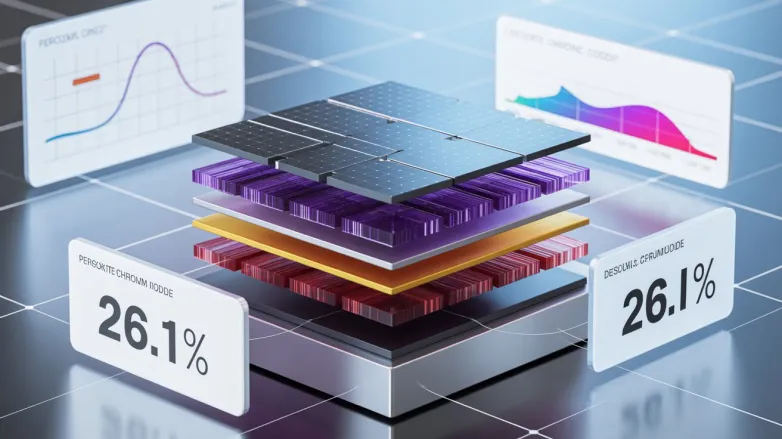Simulation predicts efficient DJ–Cs₂CrI₆ tandem perovskite solar cells achieving 26.1%
- Indian researchers simulated a tandem perovskite cell pairing a 2D DJ top absorber with a lead-free Cs₂CrI₆ bottom cell, projecting 26.1% efficiency.

A research team from Chitkara University and NIT Delhi has presented simulation results for a tandem perovskite architecture that pairs a Dion–Jacobson (DJ) 2D perovskite top cell with a lead-free double-perovskite Cs₂CrI₆ bottom cell, projecting a power conversion efficiency of 26.1% under AM1.5G. Using SCAPS-1D, the group optimized each subcell independently before stacking, targeting current matching, minimized interfacial recombination and balanced transport layers.
The top subcell employs (PDA)(MA₃)Pb₄I₁₃ with a ~1.65 eV bandgap—thermally robust and suitable for high-energy photons—while the bottom cell uses Cs₂CrI₆ at ~1.08 eV to capture lower-energy light. Key to the modeled gains were careful choices of electron/hole transport layers, defect densities, and interface passivation, which together suppressed non-radiative losses and improved open-circuit voltage. The simulated tandem suggests respectable fill factors and photocurrents consistent with near-optimum bandgap pairing.
Why it matters: perovskite tandems promise silicon-beating efficiencies, but lead content, stability and scale remain hurdles. A lead-free bottom subcell is attractive for environmental and regulatory reasons, and 2D DJ perovskites often show enhanced moisture and thermal resilience compared to pure 3D analogs. If experimentally realized, such stacks could offer a path to high efficiency with improved durability and a friendlier materials profile.
Caveats are standard for in-silico work. SCAPS-1D assumes idealized uniform layers, whereas real devices face grain boundaries, ion migration, and interlayer diffusion that degrade performance. Contact selectivity, series resistance and scalable deposition routes (slot-die, blade-coat) must be proven, as must stable, low-loss tunnel recombination junctions between subcells. Encapsulation and standardized stress testing (85°C/85% RH, light soak) will determine whether modeled gains survive manufacturing and operation.
Still, the study adds to momentum around lead-reduced tandem stacks and points to concrete recipes—bandgaps, transport layers, passivation strategies—that experimentalists can try next. Success would push perovskites closer to bankable modules by combining high efficiency with better thermal and moisture tolerance.
Also read


